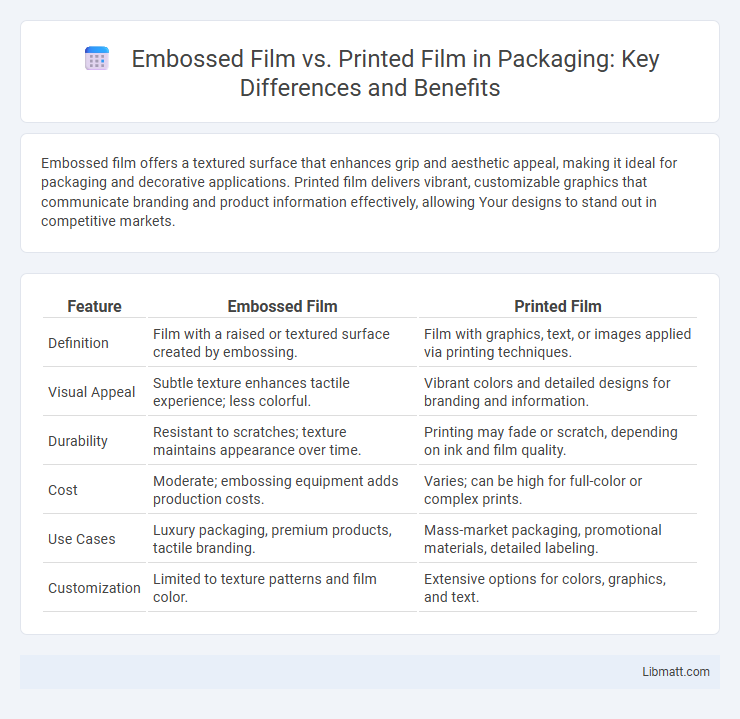Embossed film offers a textured surface that enhances grip and aesthetic appeal, making it ideal for packaging and decorative applications. Printed film delivers vibrant, customizable graphics that communicate branding and product information effectively, allowing Your designs to stand out in competitive markets.
Table of Comparison
| Feature | Embossed Film | Printed Film |
|---|---|---|
| Definition | Film with a raised or textured surface created by embossing. | Film with graphics, text, or images applied via printing techniques. |
| Visual Appeal | Subtle texture enhances tactile experience; less colorful. | Vibrant colors and detailed designs for branding and information. |
| Durability | Resistant to scratches; texture maintains appearance over time. | Printing may fade or scratch, depending on ink and film quality. |
| Cost | Moderate; embossing equipment adds production costs. | Varies; can be high for full-color or complex prints. |
| Use Cases | Luxury packaging, premium products, tactile branding. | Mass-market packaging, promotional materials, detailed labeling. |
| Customization | Limited to texture patterns and film color. | Extensive options for colors, graphics, and text. |
Introduction to Embossed and Printed Films
Embossed films feature raised or textured patterns created through heat and pressure, enhancing grip, aesthetics, and tactile appeal in packaging and labeling applications. Printed films apply graphic designs or information directly onto the film surface using various printing technologies such as flexography or digital printing, allowing for vibrant color reproduction and brand messaging. Both embossed and printed films serve distinct functional and decorative purposes in the packaging industry, influencing product differentiation and consumer engagement.
Key Differences Between Embossed and Printed Films
Embossed film features a textured surface created by pressing patterns into the material, enhancing tactile appeal and grip, while printed film showcases visual designs applied through ink or other printing methods on a smooth surface. Embossed films are often used in packaging and decorative applications to add dimensionality and durability, whereas printed films prioritize vibrant imagery and brand messaging. The choice between embossed and printed films depends on the desired sensory experience and functional requirements, such as aesthetic detail versus tactile interaction.
Material Composition and Manufacturing Process
Embossed film is typically made from polymer materials like polyethylene or polypropylene, featuring raised patterns created through a heat and pressure embossing process that adds texture without altering the base film's structure. Printed film involves similar base polymers but incorporates ink layers applied using techniques such as flexographic or gravure printing, which deposit color or designs directly onto the film surface. Understanding these differences in material composition and manufacturing processes helps you select the right film type for applications requiring either textured surfaces or vivid graphic displays.
Visual Appearance and Aesthetic Appeal
Embossed film offers a textured surface that enhances visual depth and provides a tactile experience, making packaging or products stand out with a premium, sophisticated look. Printed film allows for more versatile and vibrant designs, showcasing detailed images and complex color schemes that capture your brand's unique identity. Choosing between embossed and printed film depends on whether your priority is a tactile, elegant appeal or a colorful, graphic-rich presentation.
Durability and Wear Resistance
Embossed film offers superior durability and wear resistance due to its textured surface, which helps to mask scratches and abrasions more effectively than printed film. Printed film, while versatile in design options, tends to be more susceptible to fading, peeling, and surface damage under frequent use or harsh environmental conditions. When selecting packaging materials, your choice between embossed and printed film should consider the level of protection required to maintain appearance and structural integrity over time.
Functional Applications in Various Industries
Embossed film enhances grip, texture, and aesthetic appeal, making it ideal for packaging in food, healthcare, and consumer goods industries where tactile differentiation and product protection are crucial. Printed film offers precise branding, intricate designs, and customizable visuals crucial for marketing and product identification in sectors like retail, pharmaceuticals, and electronics. Both films serve functional roles by improving durability, visual impact, and user experience across diverse industrial applications.
Cost Considerations: Embossed vs Printed Films
Embossed films generally offer cost advantages due to lower production complexity compared to printed films, which require multiple layers and precise color registration, increasing manufacturing expenses. The durability of embossed films reduces replacement frequency, contributing to long-term savings, while printed films may incur higher costs from potential fading or peeling over time. Your choice between embossed and printed films should factor in both initial investment and ongoing maintenance expenses to ensure budget efficiency.
Environmental Impact and Sustainability
Embossed film typically has a smaller environmental footprint than printed film due to reduced use of inks and chemicals, which lowers VOC emissions and waste. Printed films often involve additional energy consumption and disposal challenges linked to ink solvents and colorants, affecting overall sustainability. Choosing embossed film can enhance Your packaging's eco-friendliness by minimizing hazardous materials and facilitating easier recycling.
Customization and Design Flexibility
Embossed film offers unique texture customization that enhances tactile appeal, allowing your packaging to stand out with raised patterns and intricate surface designs. Printed film provides extensive design flexibility through vibrant colors, detailed graphics, and variable printing techniques that can be tailored to match brand identity precisely. Combining embossed and printed films can maximize both visual impact and sensory engagement for a truly distinctive packaging solution.
Choosing the Right Film for Your Project
Choosing the right film for your project depends on the desired texture and visual impact; embossed film offers a raised pattern that enhances tactile appeal and hides scratches, while printed film provides vibrant, customizable graphics ideal for detailed designs. Embossed films are typically used in packaging to add sophistication and durability, whereas printed films serve well in branding and promotional applications. Assess the project's aesthetic goals, durability requirements, and budget to determine whether the textural elegance of embossed film or the colorful versatility of printed film best fits your needs.
Embossed film vs printed film Infographic

 libmatt.com
libmatt.com